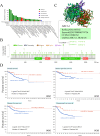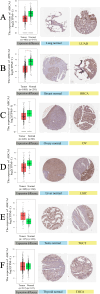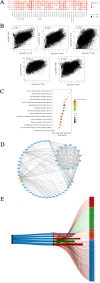A pan-cancer analysis targeting the oncogenic role of ATP-binding cassette transporter A1 in human tumors
- PMID: 40297807
- PMCID: PMC12034663
- DOI: 10.3389/fonc.2025.1513992
A pan-cancer analysis targeting the oncogenic role of ATP-binding cassette transporter A1 in human tumors
Abstract
Objectives: ABCA1 is involved in the development and progression of a wide range of malignant tumors, so to further clarify the role of ABCA1 expression therein, and to search for new breakthroughs in the treatment of tumors and cancers, we launched a thorough pan-cancer analysis of ABCA1.
Methods: Based on the manipulation of TCGA (The Cancer Genome Atlas), GEO (Gene Expression Omnibus), Human Protein Atlas (HPA) datasets and various bioinformatics tools, The oncogenic role of ABCA1 in 33 tumor types was explored from six aspects: gene expression, prognosis, variation, immunohistochemistry, correlation of tumor-associated fibroblastic infiltration, and enriched analysis of related genes. The potential value of ABCA1 was also mined, such as: ABCA1 may be a potential marker of tumor metastasis, play a role in cancer resistance, and its expression may inhibit the spread of tumor cells.
Results: Based on the analysis results, we found that ABCA1 is expressed elevated and mutated in tumor samples of 33 cancer types compared with matched normal tissues, and these mutations may be related to the mechanism of cancer, metastatic ability, and prognosis, etc. Meanwhile, we also investigated the correlation between ABCA1 expression and tumor-associated fibroblast infiltration, and described its association with corresponding miRNAs, which can provide scientific basis for clinical diagnosis.
Conclusions: Our study thoroughly illustrates the impact of ABCA1's systemic presence across various forms of cancer. Given its specificity to tumors, ABCA1 holds promise as a biomarker for cancer diagnosis, monitoring for recurrence, and predicting outcomes. Consequently, our research could significantly bolster the case for utilizing ABCA1 in the therapeutic approach to cancer.
Keywords: ABCA1; bioinformatics; pan-cancer; prognosis; survival.
Copyright © 2025 Wu, Gu, Xie, Li, Wang, Liu and Huang.
Conflict of interest statement
The authors declare that the research was conducted in the absence of any commercial or financial relationships that could be construed as a potential conflict of interest.
Figures







References
Publication types
LinkOut - more resources
Full Text Sources

